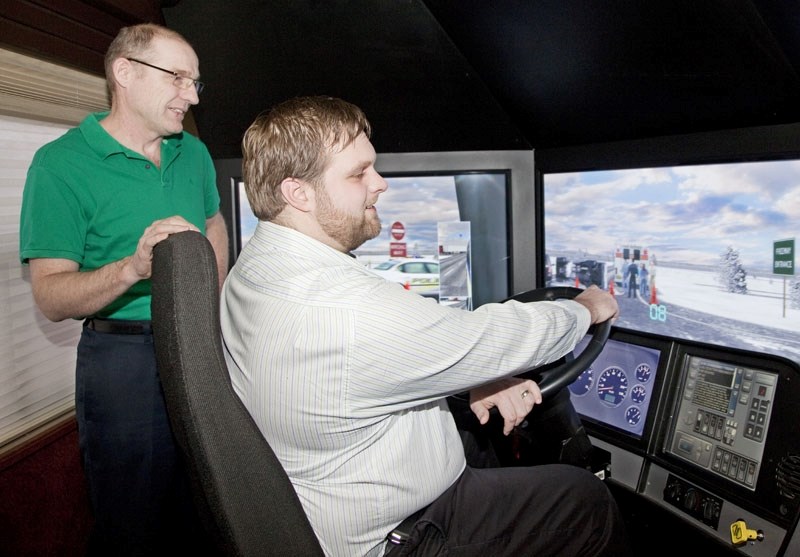It’s not often you hear a driving instructor tell a student to go ahead and give the curb a good rub.
But that’s what was happening this week at the St. Albert Transit headquarters in Campbell Business Park, where local bus drivers got a taste of simulator training in a half-million dollar mobile facility that looks like a cross between a video game and the cockpit of a jet fighter.
The simulator has benefits over traditional training techniques, which typically consist of videos and road tests in real buses, said Al Pfiefer, manager of driver development.
“If a fellow’s having a lot of problems, like in winter driving and he’s a little bit nervous, we can bring him in and put him through the program and they’re not worried about smashing into anybody,” Pfiefer said.
St. Albert Transit put all 75 of its drivers through a four-hour course on collision avoidance this week.
The simulator is owned by Pacific Western Transportation, the parent company of Diversified Transportation, which supplies all of St. Albert’s transit drivers.
The actual simulator is located in the rear of a gleaming $350,000 tour bus that was rescued from the entertainment industry about a year ago. The unit was formerly used by a famous movie star who can’t be named due to a confidentiality agreement.
The $150,000 simulator sits in the back where the king-sized bed used to be. A row of leather seats form a mini-classroom where other students can observe what the “driver” is doing.
The main benefit of the simulator is that it removes drivers from the day-to-day norm of bus driving, said lead instructor Race Dixon.
“It becomes repetitive and you become complacent to your surroundings,” he said. “When a driver becomes complacent their field of vision starts to narrow on them and they’re just starting to look out the front windshield. You want to open that field of vision up again and this helps with that,” he said.
“Their head and eyes are moving all the time, taking in all the information they should be.”
The unit’s computerized system is loaded with various buses and scenarios that subject drivers to the appearance of sudden car doors, cars pulling in front of them, pedestrians, cyclists and emergency vehicles.
The trainers work on getting the drivers to scan far ahead so they can anticipate problems and react calmly.
“Simulator training is not meant to take the place of traditional training, it’s to enhance your training programs,” Dixon said.
He spends the better part of his year taking the training bus across the country to train drivers working under the Pacific Western Transportation umbrella. It’s the only mobile unit of its kind in Canada, he said. It will likely be back in St. Albert in the summer.
Driver Jim Gauvreau, an 18-year veteran driver, thinks the simulator is a good idea.
“I like it. It opens your eyes up a little bit,” he said. “It points out some of your bad habits.”



